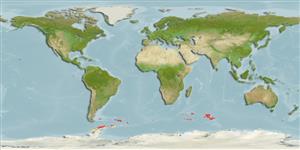>
Perciformes/Notothenioidei (Icefishes) >
Nototheniidae (Cod icefishes) > Nototheniinae
Etymology: Notothenia: Greek, 'notos', ou; νοτος, ου), from the south + Greek, 'e 'eutheneia',as or 'euthenia', as (ευθενεια, ας; ευθενια, ας), abundance (P. Romero, pers.comm. 01/16).
Eponymy: Rear-Admiral Sir James Clark Ross (1800–1862) discovered the Ross Sea and the Ross Ice Shelf and an island (1841) which Scott, on his first expedition, named Ross Island in his honour. [...] (Ref. 128868), visit book page.
More on author: Richardson.
Environment: milieu / climate zone / depth range / distribution range
Ecologia
marinhas demersal; oceanódromo (Ref. 51243); intervalo de profundidade 5 - 350 m (Ref. 28106), usually 5 - 350 m (Ref. 28106). Polar; -1°C - 5°C (Ref. 28106); 45°S - 67°S, 75°W - 165°E
Southern Ocean: northern end of the Antarctic Peninsula, Scotia Arc, Prince Edward, Crozet, Kerguelen, Heard and Macquarie islands, and Ob' and Lena banks.
Comprimento de primeira maturação / Tamanho / Peso / Idade
Maturity: Lm 49.3 range ? - ? cm
Max length : 92.0 cm TL macho/indeterminado; (Ref. 5179); common length : 50.0 cm TL macho/indeterminado; (Ref. 2121); peso máx. publicado: 10.0 kg (Ref. 5179); idade máx. registrada: 16 anos (Ref. 28106)
Espinhos dorsais (total) : 4 - 7; Raios dorsais (total) : 32 - 36; Raios anais : 26 - 30.
The sexually immature members of the population stay in lesser depths, mainly in the shallow fjord bays. Yearlings feed mainly on mesozooplankton in the near surface zone (5-15 m). Immature and mature fish are benthic but stay in shallower depths (10-20 m). Sexually mature fish move out of the fjord to stay in the shelf zone. Spawn once a year (Ref. 89316). Maximum life span for males is 12 years (Ref. 28106).
Mature females may spawn for the first time from around 6-8 years of age (Ref. 71843).
Hureau, J.-C., 1985. Family Notothenidae - Antarctic rock cods. p. 323-385. In W. Fischer and J.C. Hureau (eds.) FAO species identification sheets for fishery purposes. Southern Ocean (Fishing areas 48, 58 and 88) (CCAMLR Convention Area). Rome, FAO. Vol. 2. (Ref. 2121)
Status na Lista Vermelha da UICN (Ref. 130435: Version 2024-1)
Ameaça para os humanos
Harmless
Uso pelos humanos
Pescarias: espécies comerciais
Ferramentas
Relatórios especiais
Baixar XML
Fontes da internet
Estimates based on models
Preferred temperature (Ref.
123201): 0.7 - 4.7, mean 2.1 °C (based on 140 cells).
Índice de diversidade filogenética (Ref.
82804): PD
50 = 0.5078 [Uniqueness, from 0.5 = low to 2.0 = high].
Bayesian length-weight: a=0.00589 (0.00480 - 0.00722), b=3.19 (3.13 - 3.25), in cm total length, based on LWR estimates for this species (Ref.
93245).
Nível Trófico (Ref.
69278): 3.6 ±0.56 se; based on food items.
Generation time: 8.5 (6.1 - 9.8) years. Estimated as median ln(3)/K based on 17
growth studies.
Resiliência (Ref.
120179): Baixo, tempo mínimo de duplicação da população 4,5 - 14 anos (K=0.10-0.16; tmax=16; Fec=19,000).
Fishing Vulnerability (Ref.
59153): High vulnerability (63 of 100).
Climate Vulnerability (Ref.
125649): Moderate to high vulnerability (54 of 100).
Nutrients (Ref.
124155): Calcium = 16.7 [10.3, 37.7] mg/100g; Iron = 0.427 [0.187, 0.808] mg/100g; Protein = 18.2 [15.8, 20.4] %; Omega3 = 0.316 [0.187, 0.528] g/100g; Selenium = 18.1 [8.2, 38.9] μg/100g; VitaminA = 12.2 [2.9, 56.1] μg/100g; Zinc = 0.35 [0.24, 0.52] mg/100g (wet weight);
